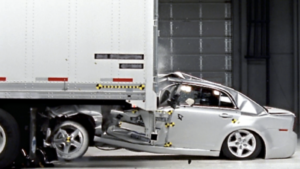Motor vehicle collisions are the leading cause of spinal cord injuries in Americans under the age of 65. Spinal cord injuries in car accidents are relatively common. Your spinal cord extends from your brainstem to your lower back region (known as your lumbar region). While the length of your spinal cord depends on your age and gender, it is a delicate component to your body that transmits nerve signals throughout your body – controlling everything from movement to breathing and body temperature.
An injury to your spinal cord might result in permanent damage – leaving you dependent on loved ones or even machines to survive.
How Do Spinal Cord Injuries Happen in Car Accidents?
Car accidents are more violent than you might realize. Everything from a defective component in the vehicle to the sheer impact could cause spinal cord injuries. Some common reasons spinal cord injuries occur in motor vehicle accidents include:
- Vehicle Rollovers – A vehicle rollover can occur at any speed, but SUVs have a higher chance of a rollover. In a rollover, the roof might collapse, making contact with a person’s head, neck or spine.
- Seatbelt Malfunction – Seatbelts save lives, but they also cause catastrophic damage when they malfunction. A faulty design might force the seatbelt to tear apart, come unlatched in an impact, and fail to restrain the driver or passenger(s).
- Power Windows – Vehicles in the United States are not required to have a safety feature that forces the window to retract when obstructed. As a result, a child’s head or neck could become trapped in a power window – even without an accident.
- Seat Back Collapses – For a vehicle to protect its occupants, all safety functions must operate together – including the seat and seatbelt. When the seat back collapses, the occupant might thrash around the inside of the vehicle or get ejected.
- Suspension Defects – Suspension defects might force a driver to lose control, and in some cases, force the vehicle to roll over.
Understanding Spinal Cord Damage
Spinal cord injuries occur when the spinal cord is damaged. These injuries result in impairment of all cord functions, including motor, sensory, and autonomic.
Motor vehicle accidents and motorcycle accidents account for 35 percent of new spinal cord injuries per year; making it a common cause of these catastrophic injuries.
Spinal cord injuries occur in two types: complete and incomplete.
However, incomplete and complete injuries may occur anywhere on the spinal column, including cervical spine, thoracic spine, lumbar spine, sacral spine, and coccygeal region. Each area of the spine controls various functions of the body.
Complete Injury
A complete injury means the victim has lost the ability to feel, move, or function from the level of injury and down. Depending on where the injury occurs in the spinal column, a person may be unable to walk, or do anything except move their head.
Incomplete Injury
An incomplete injury means that the victim might have feeling or movement below the point of injury. The amount of feeling and movement depends on the severity of the injury.
Paralysis from a Spinal Cord Injury
Depending on the severity of the injury, paralysis might occur.
Paralysis means that the victim cannot move below the injury site, and might suffer one of four types of paralysis:
- Monoplegia – Monoplegia affects one limb, such as being unable to move an arm or leg after an accident.
- Hemiplegia – Hemiplegia affects one side of the body, such as being unable to move the arm and leg on the right or left side.
- Paraplegia – Paraplegia affects both legs. In some cases, the victim might have pelvic paralysis too.
- Tetraplegia – Tetraplegia affects both legs and both arms. Often called quadriplegia, this is the most severe type of paralysis.
Recovery and a Spinal Cord Injury
Recovering from a spinal cord injury varies from person-to-person. Factors like the severity of the injury, the patient’s other injuries, and how quickly the injury receives treatment all determine if the victim recovers fully.
Incomplete spinal cord injuries are more common than complete spinal cord injuries, but it is imperative that the victim receives medical treatment quickly to reduce swelling – which helps avoid permanent damage to the spinal cord.
Once a spinal cord injury occurs, no cure exists. Certain medications given immediately after an accident, such as steroids, might reduce swelling and prevent permanent damage. Other times, the wrong drug can exacerbate the injury – causing permanent damage.
Does a Person Fully Recover?
When a spinal cord injury occurs, the first step for physicians is reducing swelling. After a few days or weeks, swelling might decrease enough so that the victim regains some function.
Even with function slowly returning, the process of recovery is long and painful. Victims might spend months or years in physical therapy, endure multiple surgical procedures, and might never be 100 percent recovered.
Receiving Compensation for a Spinal Cord Injury
When a victim suffers a catastrophic spinal cord injury in a motor vehicle accident, they may receive compensation for that injury.
The costs of spinal cord injuries are extensive.
The purpose of compensation in a spinal cord injury lawsuit is to compensate the victim for monetary losses caused by the incident. The damages awarded (compensation) are designed to restore the victim back to their pre-injured state.
Naturally, no amount of money can return a victim’s ability to walk or function, but the compensation may help restore them financially to a pre-accident state.
Depending on the severity of the injury, a victim might receive compensation for:
- Medical Costs – Including initial treatments, surgeries, hospitalizations, future treatments, medical equipment, and long-term care costs.
- Lost Wages – Including hours missed at work, sick leave taken, hours missed for trial days, and any wages the victim loses because of the accident.
- Loss of Earning Capacity – In permanent spinal cord injury cases, victims may not ever be able to return to work. Therefore, they may receive compensation for future wages they would have earned had the accident not happened.
- Pain and Suffering – This includes surgeries, recovery, treatments, and permanent pain and suffering the victim goes through due to their injuries.
Speak with a Personal Injury Attorney Today
If you or a loved one suffered a spinal cord injury in a motor vehicle accident caused by a negligent motorist, you might qualify for compensation.
To explore your options, you need an advocate to assist you with your case.
Contact us today to schedule a consultation.



